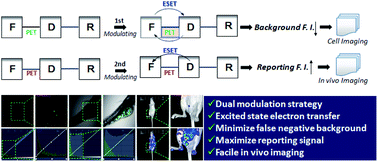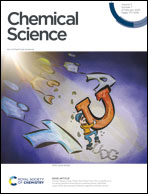The cross-talk modulation of excited state electron transfer to reduce the false negative background for high fidelity imaging in vivo†
Abstract
In practice, high fidelity fluorescence imaging in vivo faces many issues, for example: (1) the fluorescence background of the probe is bleached by the wide intensity scale of fluorescence microscopy, displaying an inherent false negative background (FNB); and (2) the dosage of the probe has to be increased to achieve sufficient intensity for in vivo imaging, causing a vicious cycle that exacerbates the FNB. Herein, we constructed a fluorophore (F)–electron donor (D)–electron regulator (R) system, and thereby developed a dual modulation strategy for the de novo design of high fidelity probes. Using cross-talk modulation, the probe allows: (1) enhanced ESET (excited state electron transfer) from F to D, which minimizes the inherent FNB based on synergistic PET (photo induced electron transfer); and (2) the inhibition of PET and weakening of ESET from F to D to maximize the reporting intensity to further reduce the FNB, which is additionally enhanced by an overdose of the probe. To test the implementation, we constructed a 7-hydroxy-2-oxo-2H-chromene-3-carbaldehyde (HPC) series of probes, with HPC (F) as the fluorophore, 2-hydrazinylpyridine, which was screened as an electronically adjustable donor (D), and electronic regulators (R). In particular, HPC-7 and HPC-8 provided cell/zebrafish imaging with negligible background even using the rather low fluorescence scale of microscopy (a region for revealing hidden background). Interestingly, with the specificity of HPC for reporting zinc, we achieved probe HPC-5, which possesses both an ultralow inherent FNB and optimal reporting intensity for tissue and in vivo imaging, enabling the in vivo imaging of zinc in mice for the first time. Under this high-fidelity mode, the fluorescence monitoring of zinc ions during the development of liver cancer in mice was successfully performed. We envision that the dual modulation strategy with the F–D–R system could provide a useful concept for the de novo design of practical probes.



 Please wait while we load your content...
Please wait while we load your content...